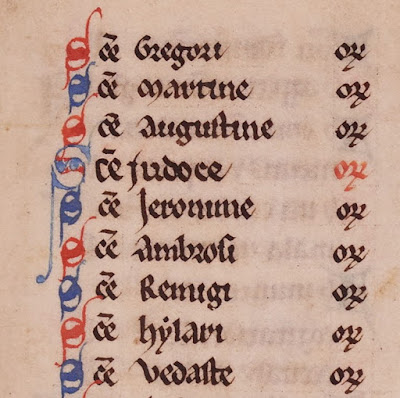 |
| Smith College, Northampton, MA, MS. 291, p.13 [All images from Digital Scriptorium] |
I visited Smith for the first time last November, and wrote one post as a result, but have always intended to do more. Here I return to my notes on MS 291, a mid 13th-century Psalter.
It has one fine historiated initial, shown above. One of its other interesting features is that it preserves a protective textile curtain (apparently original, or at least medieval):
There is currently only a very brief description online, so it may be useful to first describe the textual contents (the calendar leaves are not numbered; the rest of the book is paginated, not foliated, and p."127" is repeated):
- (pp.[i–xii]) Calendar.
- (pp.1–176) Psalms 1-150, with major illuminated initials at the usual 10-part divisions (only the first is historiated).
- (pp.176–208) The six ferial canticles, followed by the Te deum, Benedicite, Benedictus, Magnificat, Nunc dimittis, and Quicumque vult.
- (pp.209–216) Litany of saints, followed by petitions and collects.
- (pp.217–220) Commendation of souls.
- (pp.220–229) Office of the Dead, Use of Paris.
- (p.229) Prayers to Sts Elizabeth and Mary Magdalene.
- (pp.231–233) A prayer by Maurilius of Rouen (d.1067), "Singularis meriti ...".
- (pp.233–239) The prayer "O intemerata ...", written for a female supplicant (a fairly early example of the prayer).
- (pp.239–240) Extract from John's Gospel (John 1:1–14).
- (p.240) Prayers to Sts Nicaise, Thomas the apostle, Martin, and Margaret.
- (pp.[241–242]) Blank except for added inscriptions.
- (pp.[243–244]) Short prayers, including one to Mary Magdalene.
- (p.[245]) Blank except for an added inscription.
6 Feb.: Vedasti episcopi [&] confessoris, i.e. Vedast (alias Vaast), bishop of Arras and Cambrai, whose relics were at the abbey of St-Vaast, Arras.
Among the entries in ordinary brown ink is the "relatio" of Vedast (15 July), a feast that is rare outside Arras:
Among other feasts in the calendar are:
11 March: Vindicianus, bishop of Cambrai and Arras, whose relics were at Arras.
13 Dec.: Autbert, bishop of Cambrai and Arras.
13th-century additions, in a paler ink, include:
24 Jan.: "Elevatio sancti Autberti episcopi et confessoris".
4 Feb.: Lietphard (alias Lifard), who was venerated at Cambrai.
27 Feb.: Ragnulf, whose relics were at Arras.
12 Aug.: Gaugeric, bishop of Cambrai.
25 Sept.: Firminus, bishop of Amiens, principal patron of Arras.
19 Oct.: Amatus, bishop of Sens, also venerated at Cambrai and Arras.
There is ample evidence in the calendar, therefore, to associate the book with the city or diocese of Arras in northern France (Cambrai is less than 25 miles south-east of Arras):
But it is notable that only one saint, Judoc, has his name written in larger script, with the "S" of 'Sancte' also written larger, and in two colours, and with the "or" (short for 'ora pro nobis') written in red:
The centre of the cult of Judoc, alias Josse or Jodocus, was the Abbey of St Josse which, from 1161, was at Dommartin, to the west of Arras:
As mentioned above, the "O intemerata" is written for a female supplicant:
 |
| "... et esto mihi peccatrici ..." |
- 3 Jan.: Genevieve, patron of Paris (who also appears in the Litany).
- 17 Jan.: Sulpice, to whom the church of St-Sulpice in Paris is dedicated.
- 28 May: Germanus, 'bishop and confessor of Paris' (thus distinguished from Germanus 'bishop and confessor of Autun', on 31 July).
There are a few clues as to the identity of the original owner, such as the selection of saints venerated in the prayers. In 1640 it was owned by someone who wrote on the final page:
"Ce livre a/partiene a son / Maistre qui du / son [... ?] / 1640", and below this in 1837 someone calculated that 1640 was 197 years ago.
The Psalter was mentioned by Lisa Fagin Davis on her blog, with an excellent high-resolution image taken by Martin Antonetti.










There is a comparable psalter in th Bibliotheque municipale in Saint Omer Ms 232. It is made for the Abbay of Saint Bertin (Saint Omer) and is fully digitized https://bibliotheque-numerique.bibliotheque-agglo-stomer.fr/viewer/18785/?offset=6#page=7&viewer=picture&o=download&n=0&q=
ReplyDeleteKarl-H. Hellenbrand, Trierweiler